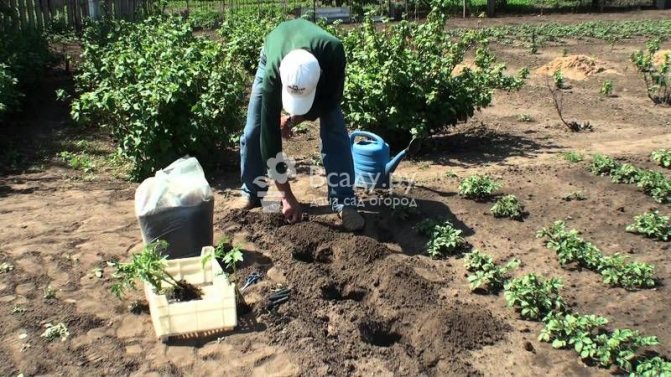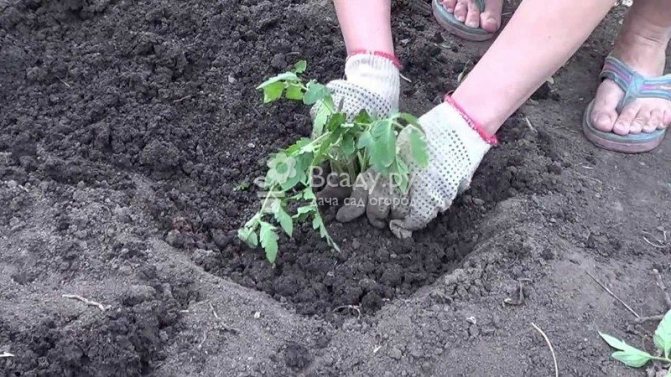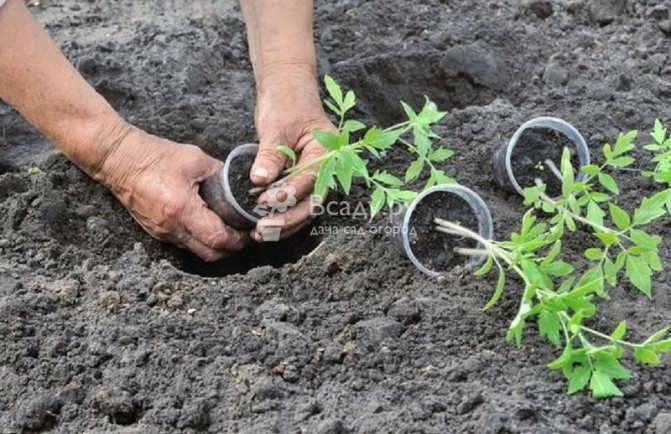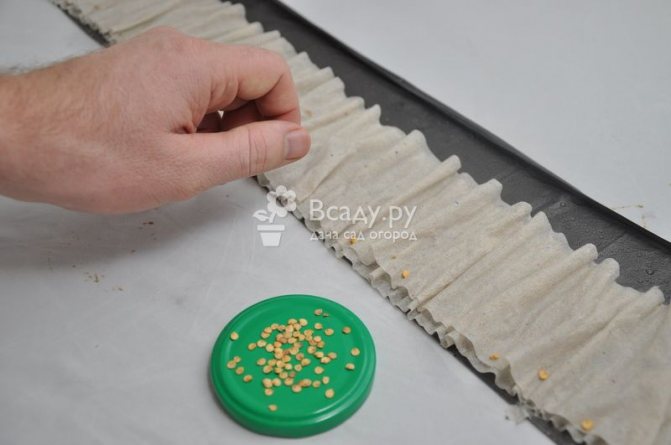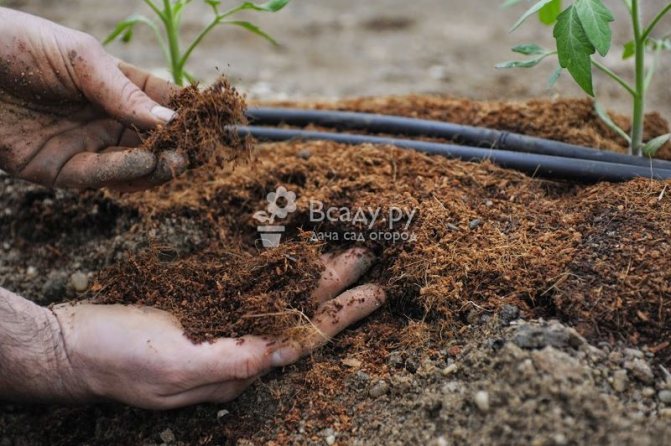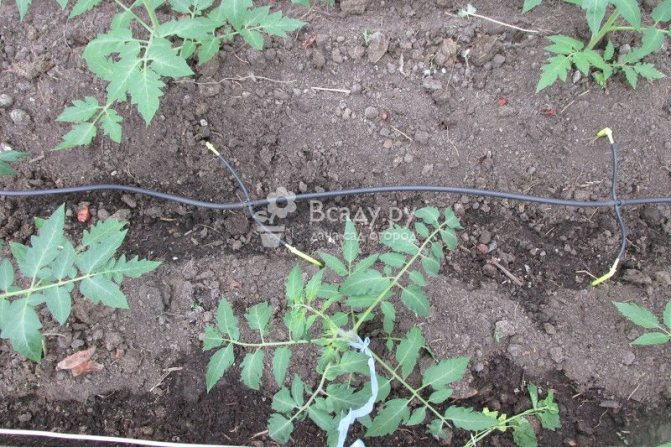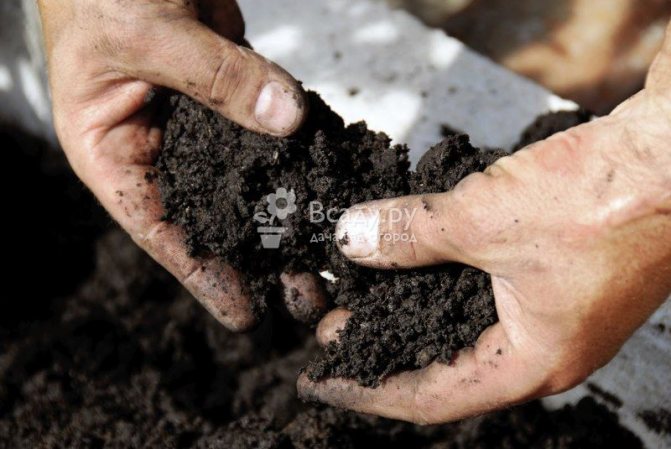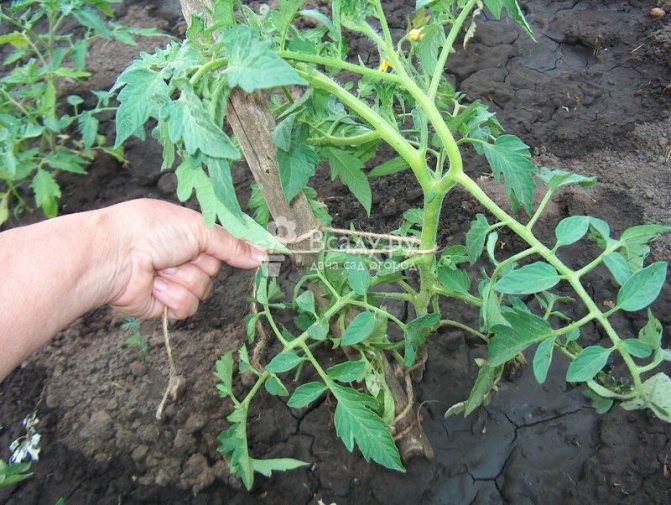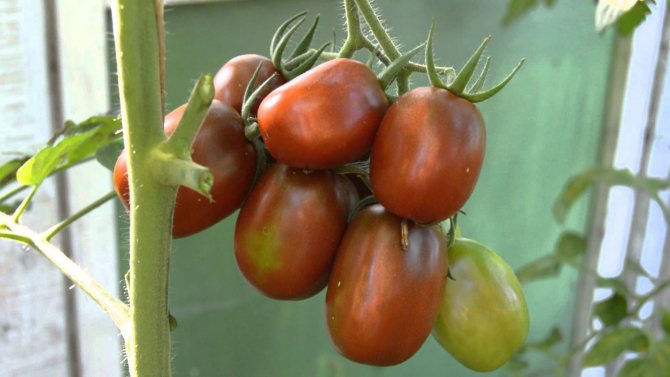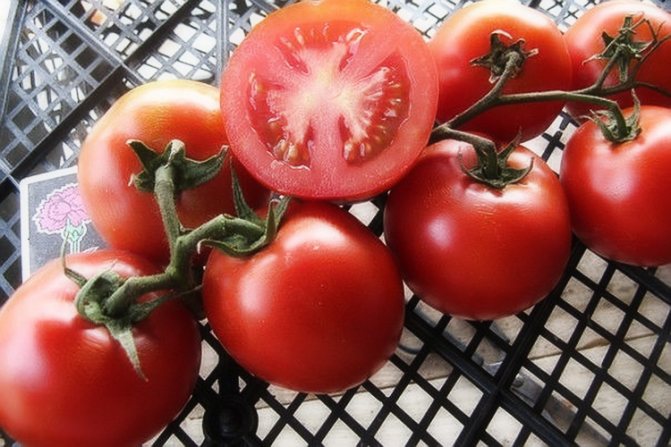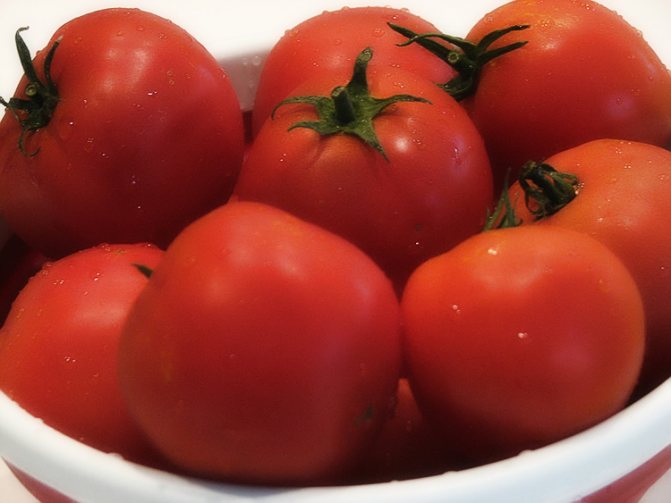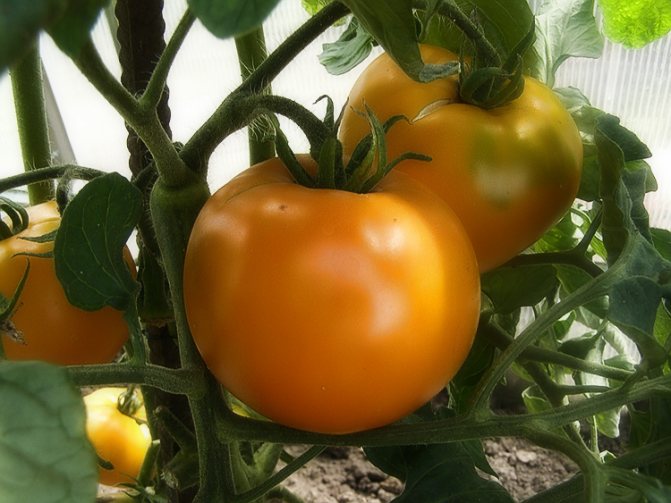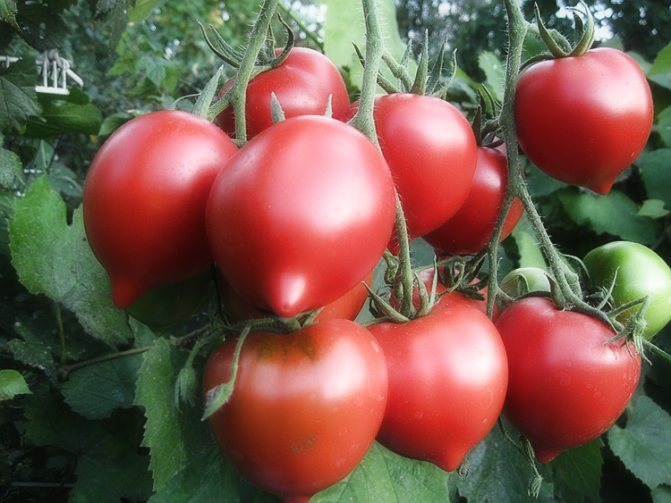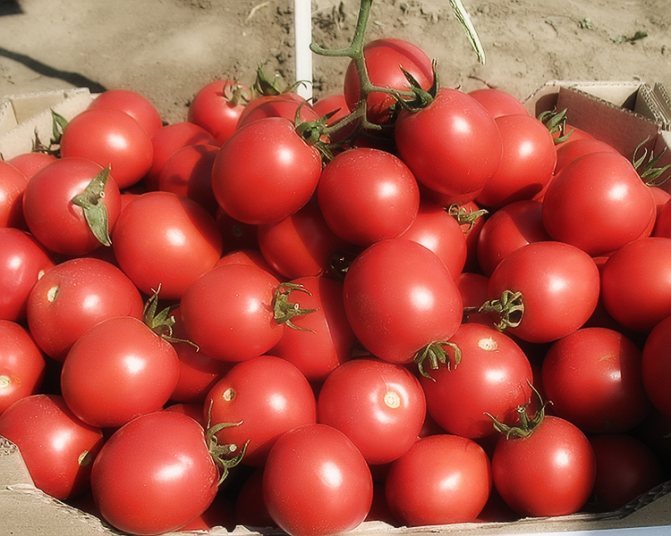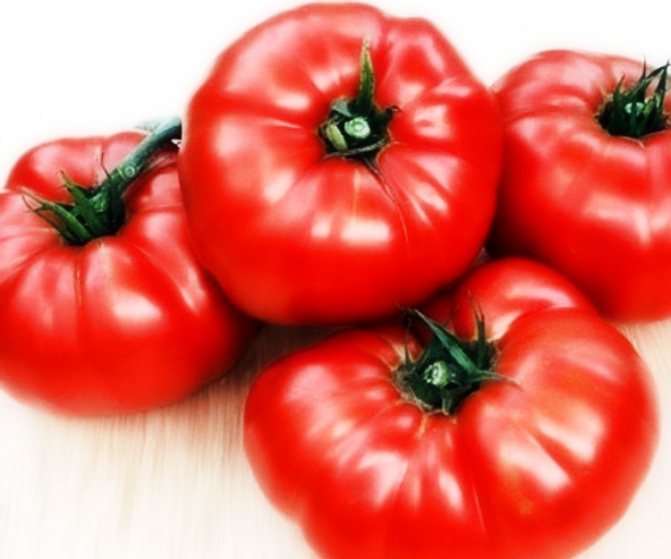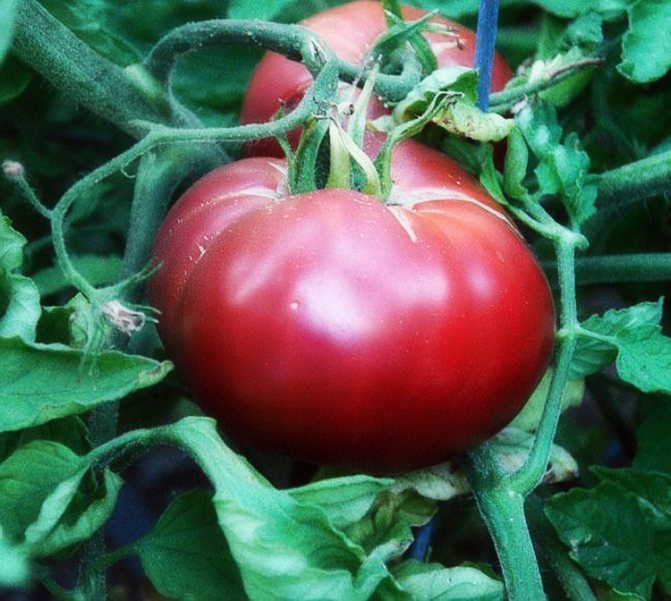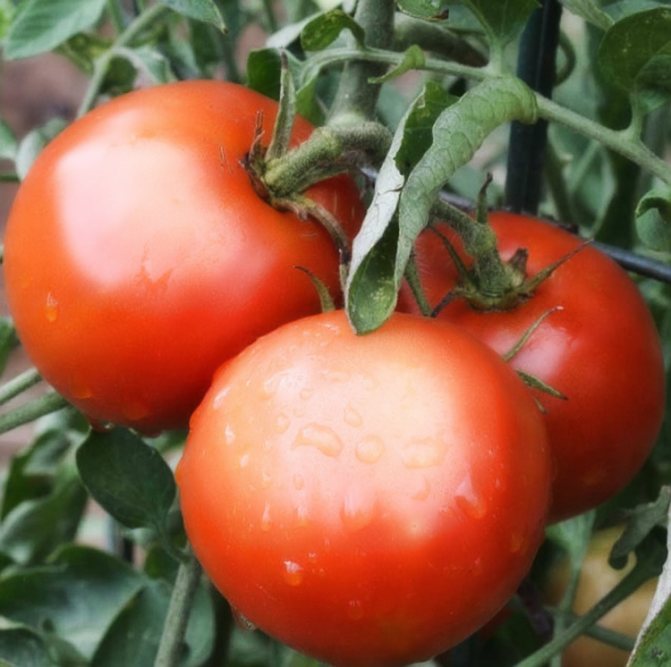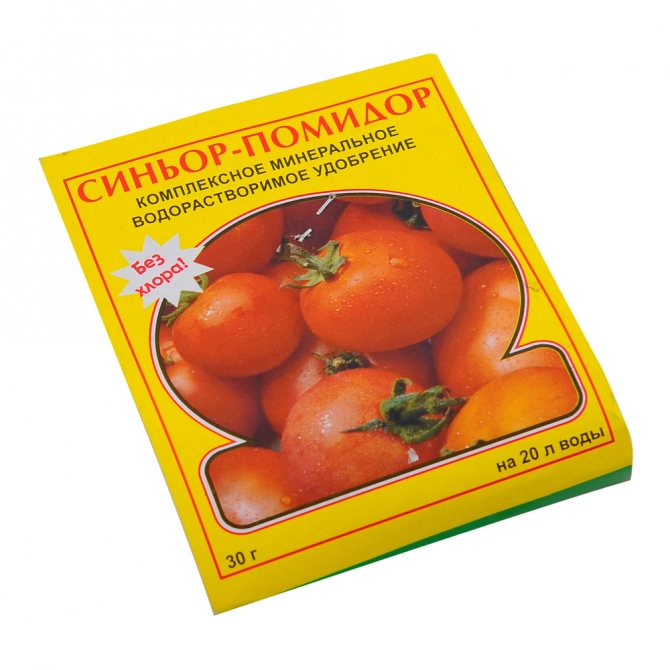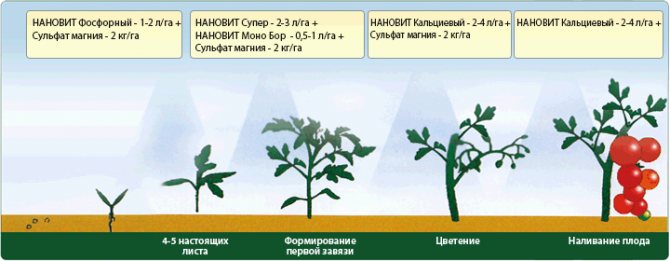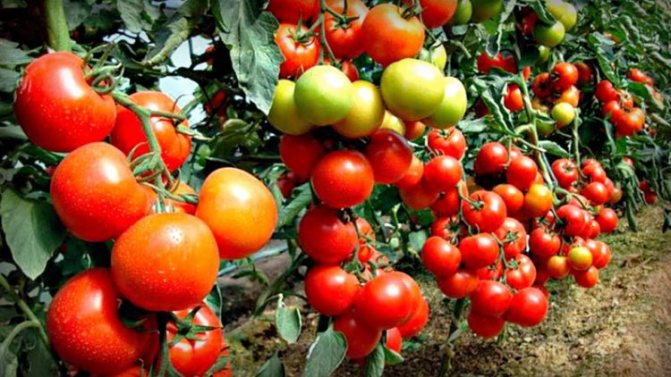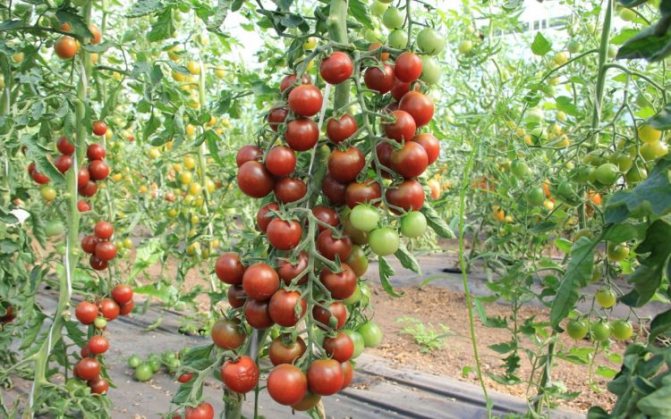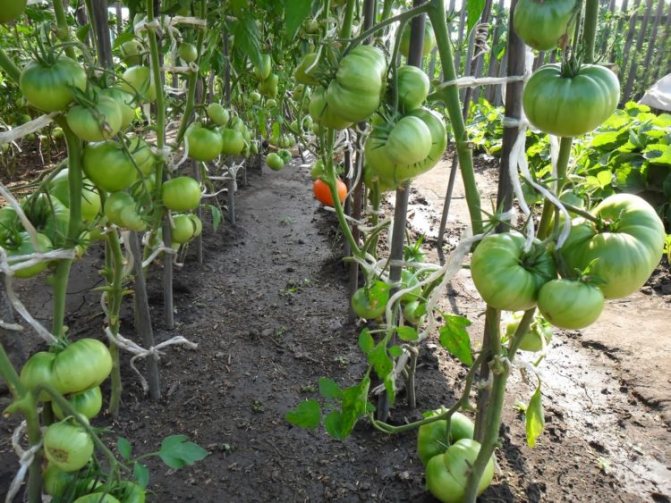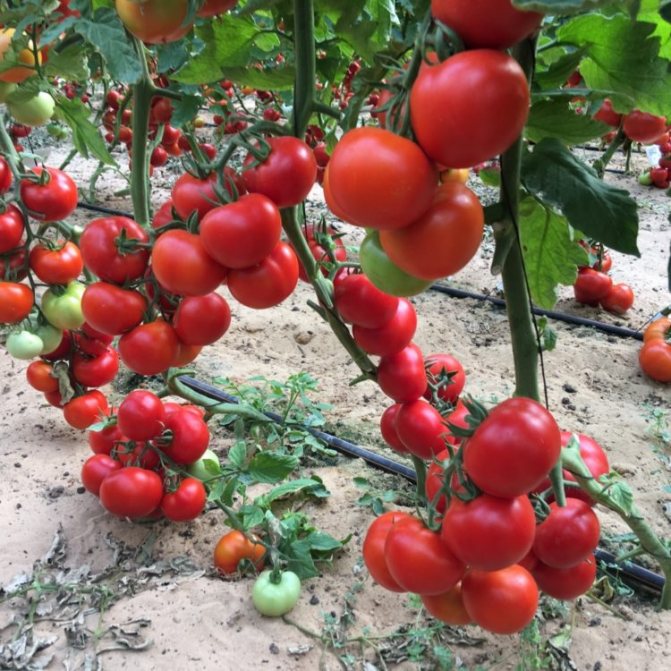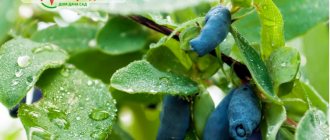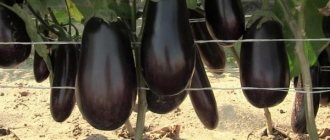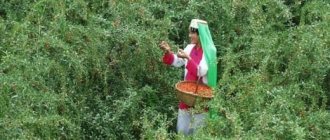Tomatoes are often grown in a greenhouse or greenhouse. However, caressed by the sun and rain, they give more tasty and healthy fruits. But in order to get them, you need to clearly know how to grow tomatoes outdoors... This task is within the power of any gardener.
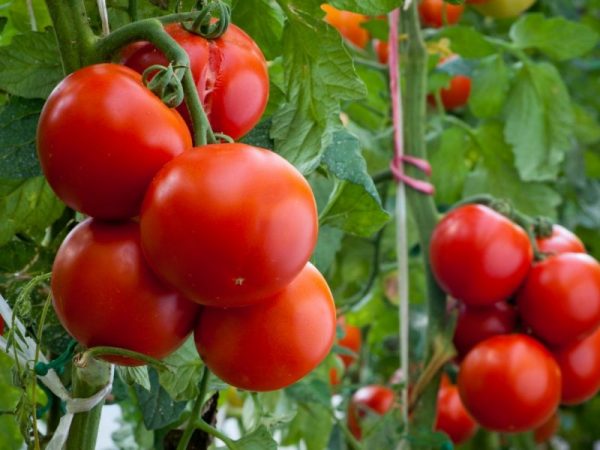
Outdoor-grown tomatoes are tastier and more aromatic
Criteria for choosing tomatoes for open ground
So that the future harvest does not keep you waiting, it is recommended to choose a cultivar that suits the preferences of the gardener, as well as the climate conditions in which the planting is carried out. Here are the criteria that will be conveniently guided by:
1. Zoning. The main condition that both experienced and novice gardeners observe. Breeders approach the creation of hybrids with great responsibility, so the varieties differ in certain preferences for climatic conditions. Some tomatoes grow in the north, others in the south. Some like dry weather, while others prefer constant rains.
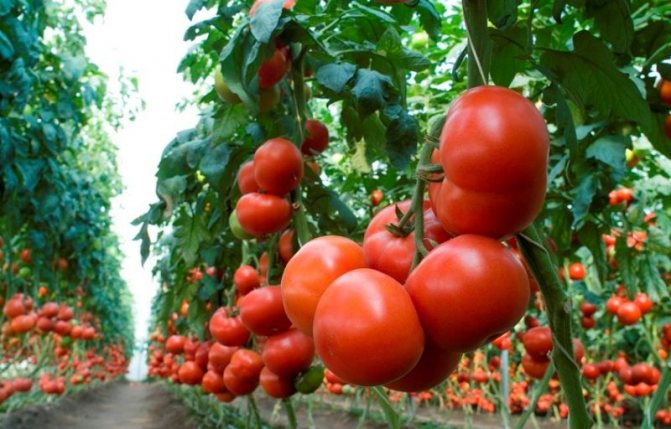

2. Place for landing. The concept of "open ground" is quite broad. For example, some gardeners plant seedlings in open areas where the wind is constantly blowing. Professionals, on the other hand, prefer to create artificial protection from the elements. In addition, it is important to take into account the acidity of the soil, as well as its structure, since the quality of the crop directly depends on this.
3. Ripening period. A moment that should also be considered first. Tomatoes are a light-loving culture, so if you choose a variety for planting in autumn that will grow for too long, you may encounter the problem that many flowers simply will not set fruit. In addition, it is important to plan at what time of the year the most crops should be harvested in order to sell them at a favorable price.
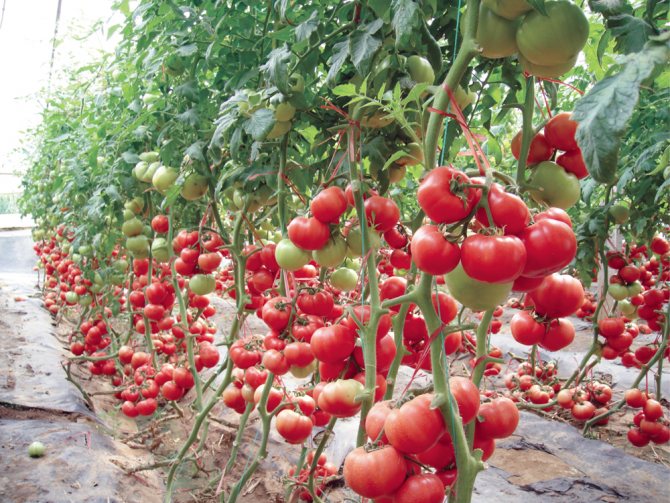

4. Availability of time for leaving. Well, the last point is whether the gardener has the opportunity to tinker with seedlings, constantly tie up the stems, remove stepsons, and so on. Most tomatoes require a lot of care, but there are also varieties that forgive gross mistakes for novice gardeners and will not wither if he suddenly forgets to water or feed the bushes in time.
Well, the fact for which purpose it is planned to grow the crop deserves a separate mention. For spinning, varieties that give small but tasty fruits are suitable. For sale, it is best to plant a crop that yields tomatoes from 250 to 300 grams (the optimal size for sale). Well, if you plan to process the entire crop for juice or pasta, then you should give preference to those varieties that give large berries.
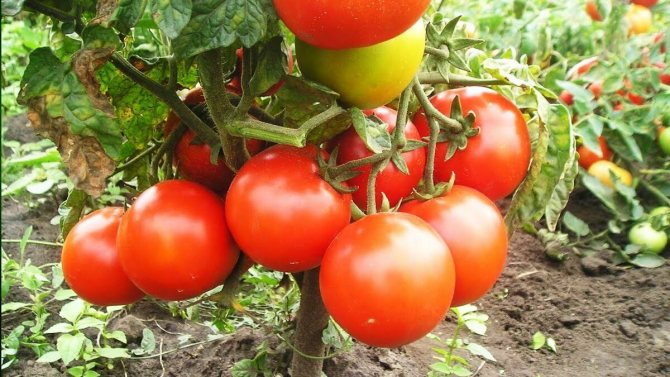

Seed preparation for sowing
To begin with, the seeds are prepared for sowing. The most productive specimens are selected by immersing them in a saline solution (1 teaspoon of salt per 200 ml of water). Those that are on the surface are thrown away. The rest are warmed up. The seed is placed in bags and placed on the battery for 2-3 days.
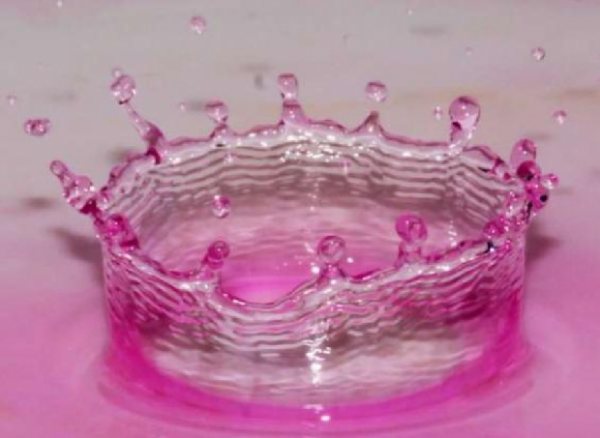

Seed dressing in potassium permanganate will protect against infections
To reduce the chance of infection, do etchant... For this, the seeds are immersed in a weak solution of potassium permanganate for 20 minutes or for 8 minutes in 3% hydrogen peroxide at t = 40 ° C.
Increases the germination and yield of tomatoes by treating seeds in nutrient solutions - for example, Epine, potassium humate or potato juice, agave... After such treatment, you do not need to wash the seeds.
Since tomatoes are thermophilic, the procedure is useful hardening... The hatched seeds are placed in the refrigerator for 12 hours, and for the day they are brought into a room with a temperature of 20 ° C.
Prices for potassium permanganate
potassium permanganate
Sowing seeds for seedlings
The substrate for vegetables is bought in a store or prepared independently, mixing sod and humus soil in equal parts. If the friability is insufficient, it is increased with peat and sawdust.
You can learn more about preparing the soil for growing tomato seedlings by reading the article on our website.
Sowing is done in mid-March. They make a depression 1 cm, put the seeds and sprinkle with earth. The box is covered with a film that is periodically removed. The container is left at a temperature of 25 ° C.
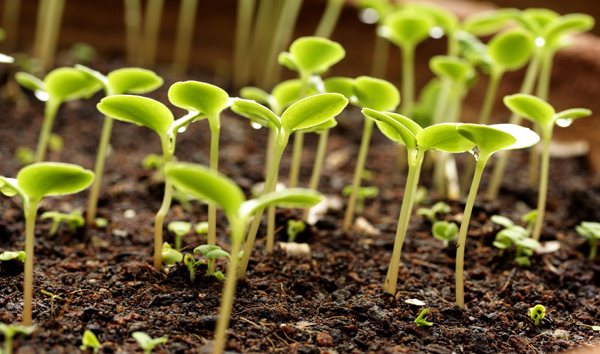

Seedlings are expected in a week
The sprouts appear in a week. The containers are placed in a well-lit place at a temperature of about 20 ° C during the day and 15 ° C at night. Daylight hours should be at least 12 hours. The first 5 days you need round-the-clock supplementary lighting. Seedlings are not watered until the first leaf appears. If the soil is very dry, it is sprayed with water from a sprayer. Then watering is increased up to 2 times a week.
You can find out more about growing tomato seedlings by reading an article on our portal.
Seedling picking
Tomato seedlings are planted in separate pots when two real leaves appear on the sprouts. Sometimes this process is postponed until 4–6 leaves grow back.
For 1-2 days, the seedlings are watered abundantly. The soil is taken the same as for sowing seeds. You can add to it superphosphate, vermicompost, potassium sulfate.
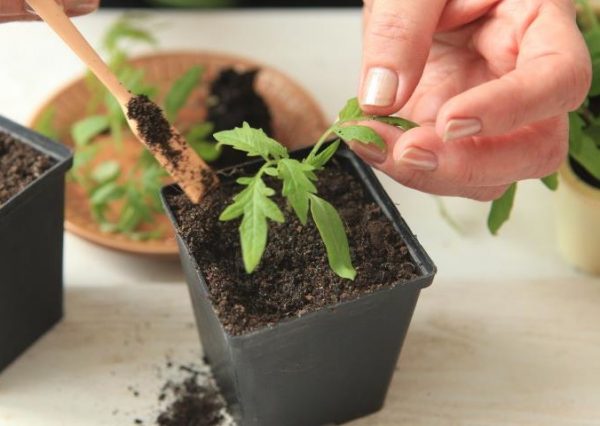

Seedlings dive when there are 2-6 true leaves
You can find out more about picking tomato seedlings here.
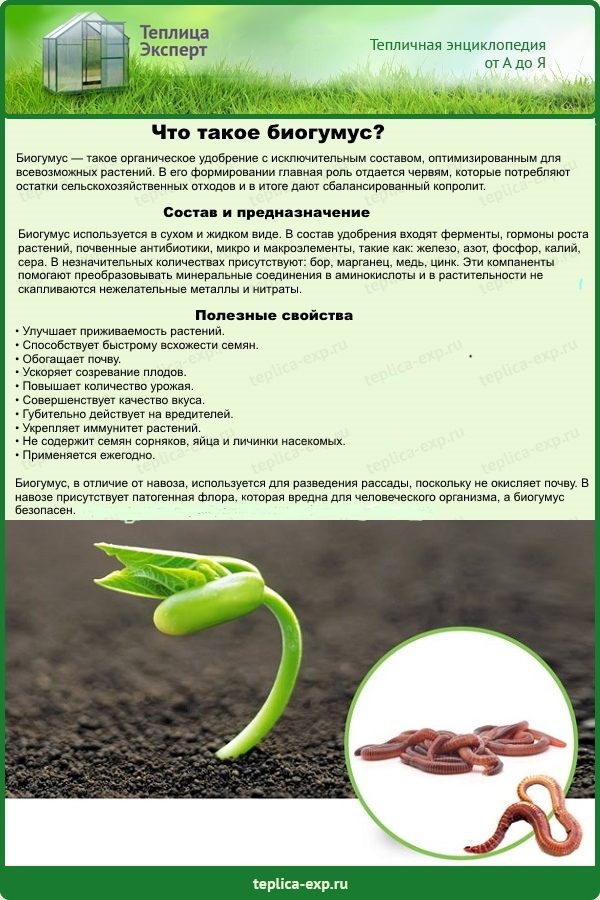

What is vermicompost?
Potassium sulfate prices
potassium sulfate
Hardening of seedlings
Quenching is carried out at a temperature of 10 ... 12 ° C. The plant is exposed in a well-lit area, but shaded from direct sunlight.
Attention! The hardening place must be protected from drafts, otherwise the seedlings will die.
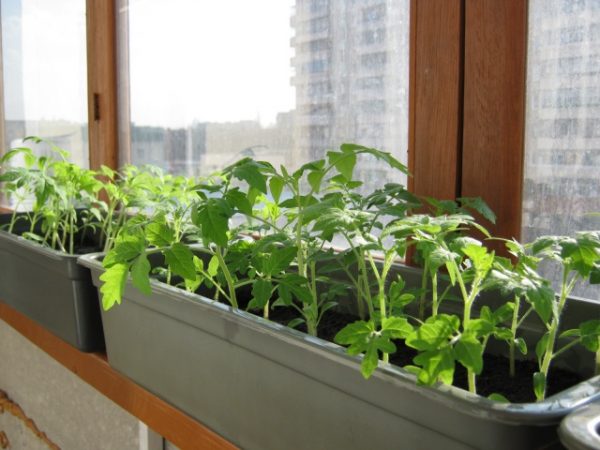

Tomato seedlings are best hardened on the balcony
Rating of the best tomatoes for the garden
Among the thousands of varieties and varieties of crops, it is difficult for a novice gardener to choose one that is suitable for growing on his site. Therefore, it is recommended to use the top, compiled on the basis of reviews from professional vegetable growers:
1. Boney MM. According to experienced gardeners, these tomatoes are considered one of the best for outdoor cultivation. All this is due to the fact that the fruits ripen in an ultra-short time, and are also large in size. The height of the bush is from 50 to 60 centimeters, so it will not be difficult to take care of the plant.
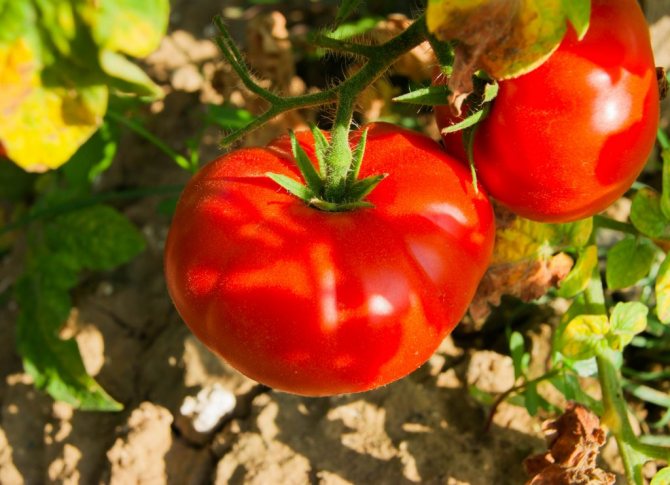

Boney MM
2. Kiss of geraniums. Another popular determinant variety, the seedlings of which can be grown both on the balcony and in the open field. The compact plant produces a large number of small fruits (40-50 grams), which makes the variety popular among fans of spinning. The bushes are extremely rarely affected by diseases and bear fruit at any time of the year.
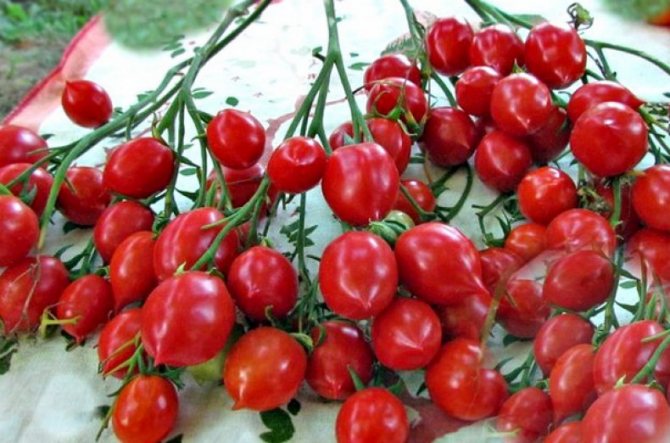

Geranium kiss
3. Sanka. A determinant variety that can be called universal without exaggeration. The plant is extremely unpretentious to the quality of the soil, and also does not need pinching. The fruits have a classic shape and are arranged in about 3-4 pieces on a tassel. The pulp is quite fleshy, tender and very aromatic. Berries are prone to cracking due to temperature extremes.
Sanka
4. Caspar 2 F1. Another variety bred by Russian breeders.Differs in cylindrical fruits, each weighing from 85 to 100 grams. The skin is slightly rough, but the variety is excellent for processing into tomato paste and juice. Can be grown both in greenhouses and outdoors. Practically not susceptible to pests, including whitefly.
Caspar 2
5. Parsley is a gardener. This mid-season variety of pink tomatoes was brought from Altai and since then has been very popular among gardeners. Its main advantage is its resistance to cold weather. Breeders claim that plants will not die even at 0 degrees Celsius. It is recommended (but not necessary) to tie the bushes to a support, as well as remove stepsons.
And these are just 5 of the most common varieties that are suitable for growing in most regions of Russia. However, favorites can also be distinguished among certain categories.
How to grow tomatoes in a pot
If you do not own a plot, you do not have a vegetable garden, but still want to pamper yourself with fresh vegetables, if you like tomatoes, how to grow them in such cases? It's pretty simple.
Instead of a garden bed, a porch, balcony or window sill will be enough. You will need an ordinary flower pot that is 50-60 centimeters high and 40-50 centimeters in diameter. The container must be filled with soil and fertilizers. All this can be purchased in specialized stores, in the markets or ask your friends summer residents.
Plant a plant in the finished soil and cover the soil with a piece of plastic, in which you make a hole for water in advance. This design will help you keep the plant free from insects, weeds, and animals.
Next, you need to lightly tie the plant to bamboo, wood or plastic racks. Then periodically water, leave on the sunny side and after a few months enjoy homemade ripe tomatoes.
Early and super-early varieties
Golden stream
A little-known but extremely high-yielding variety that was bred for outdoor cultivation without pinching. The leaves are of a standard type, but the oval-shaped fruits form whole clusters, which is why it is recommended to remove them unripe. Each tomato weighs between 90 and 120 grams. They have a weak aroma, but a rather fleshy structure. The tomato is suitable for processing.
Don Juan
One of the most unpretentious tomatoes, the ripening period of which is from 80 to 95 days. The bush reaches a height of 50 centimeters, and the round-shaped fruits generally weigh 45-60 grams. Tomato is suitable for curling as it has a pronounced taste. The hybrid is resistant to harsh climatic conditions, so it can be grown almost everywhere.
Labrador
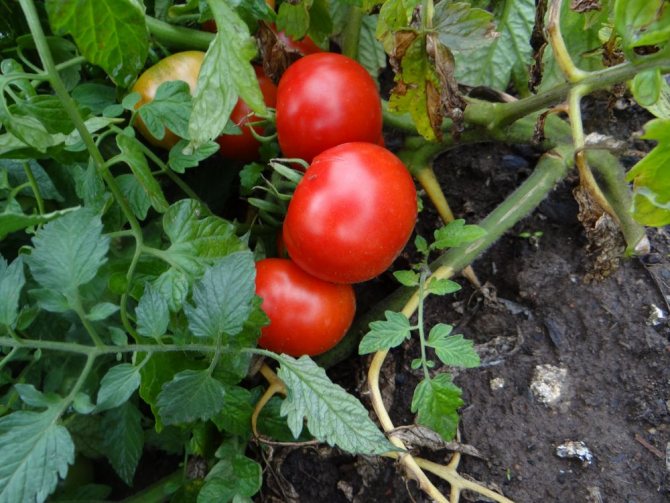

A distinctive feature of this variety is the standard-shaped bushes, reaching a height of 0.5 to 0.7 meters. Harvesting will have to be about 105 days after germination. Tomatoes are medium in size (from 80 to 150 grams), as well as sweet and sour taste, making the variety considered universal.
Bullfinch
One of the earliest varieties (from 94 to 97 days), requiring little maintenance. It is extremely popular among gardeners living in central Russia. The height of the bush is 45-50 centimeters. Inflorescences begin to form under the sixth leaf. The berry reaches a mass of 150-200 grams and is perfect for sale.
Aphrodite
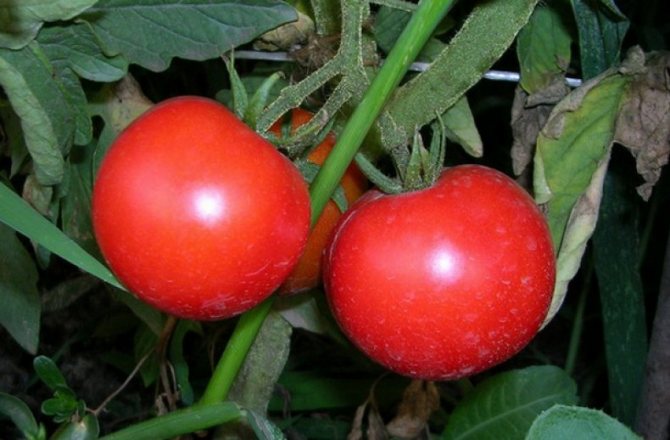

The record holder among ultra-early varieties (ripening period from 75 to 80 days), which does not require pinching, but a garter to a support is desirable. It differs in an inflorescence with 6-8 fruits, each of which reaches from 110 to 115 grams. Plants can be grown in close planting (pattern - 50 x 40 centimeters).
Stepping
Do not forget about pinching, this is very important in the tomato business. By removing the stepsons, the plant ceases to waste energy and food on unnecessary shoots. Gardeners sometimes feel sorry for removing side shoots and pinching the top.The result is a branchy bush without fruit.
Passionking should be done on time. Stepchildren (shoots growing from the sinuses) are removed at a height of 3-4 cm. When removing large stepchildren, the plant experiences stress, its defenses decrease, and it begins to hurt.
It is better not to leave the hemp at the stepchildren so that bacteria do not penetrate there. Although some gardeners believe that it is more correct to pluck them, others believe that it is better to leave a stump 1 cm so that the shoots do not grow back.
High-ripening and large-fruited varieties
Orange
Indeterminate tomato with medium ripeness and tall bushes (up to 1.5 meters). It is not difficult to understand from the name that the plant was bred by crossing a tomato with oranges, so its fruits are orange in shape. The first inflorescence is laid under 8-9 leaves, and every subsequent one - every three. If you make a good support for the culture, then it will bear fruit within 4-5 months.
Three fat men
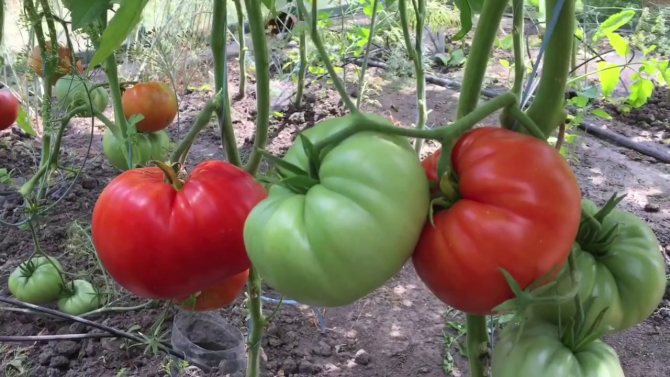

From the name it is clear that a distinctive feature of the variety is its rather large fruits (up to 400 grams), which are usually tied in 3 pieces per brush. However, tomatoes are practically not susceptible to cracking due to heat and overflow. Also, the variety has good disease resistance.
Big Beef
An early ripe variety (99-105 days) with rather powerful, spreading bushes. The height of the plant is about 1.8 meters, so it is important to tie up the culture and pinch it from time to time. Fruits are medium in size (150 to 250 grams) and taste good. In addition, tomatoes are characterized by good keeping quality and transportability.
Pudovik
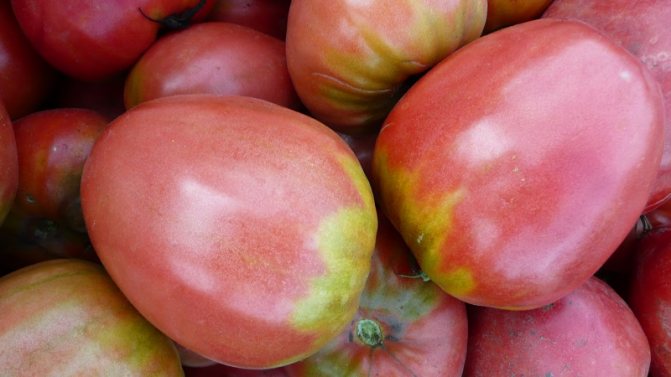

A high-yielding mid-season variety that can be grown both outdoors and in a greenhouse. It is highly desirable to form a crown and regularly pinch the bush to avoid breaking off. Large fruits reach from 300 to 500 grams (some even grow to 800) and are great for consumption and processing.
The most delicious and sweetest tomatoes
Roma
The tomato is notable for its average ripeness, as well as the possibility of growing in greenhouses and outdoors. The bushes grow in height from 06 to 0.8 meters. Partial garter and pinning required. The fruits usually form under the 7th leaf and are also slightly elongated. They are good both for curling (60-80 grams) and for consumption.
Siberian trump card
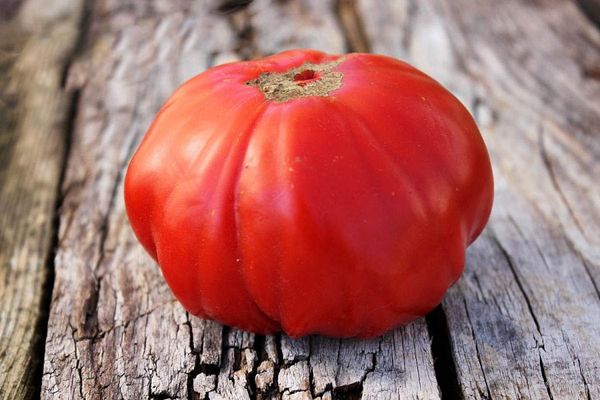

Determinant mid-season variety, the height of the bush is 0.8 meters. Fruit weight reaches 300-500 grams, due to which they have a very presentable presentation. Virtually not prone to top rot. The plant is suitable for growing in the Central lane, as well as in Siberia.
The Tsar Bell
Determinant variety for open ground and greenhouses, characterized by average sizes: bush heights from - 0.8 to 1 meter, tomato size - from 250 to 350 grams. Tomatoes are characterized by rich flavor and juiciness. An option for those who like to spin tomato juice for the winter.
Sweet heart F1
One of the most popular varieties among novice gardeners, which does not require special care, but has rather tasty medium-sized fruits (250-300 grams). Also, the tomato is practically not susceptible to diseases and is easily grown even in harsh climatic conditions.
Pink honey
A high-yielding pink tomato variety that can be grown outdoors even in late winter. Large tomatoes (350 to 500 grams) are tied about 3-4 pieces per brush. However, so that the bush does not break under the weight of the fruit, you will have to regularly form the crown.
Appetizing
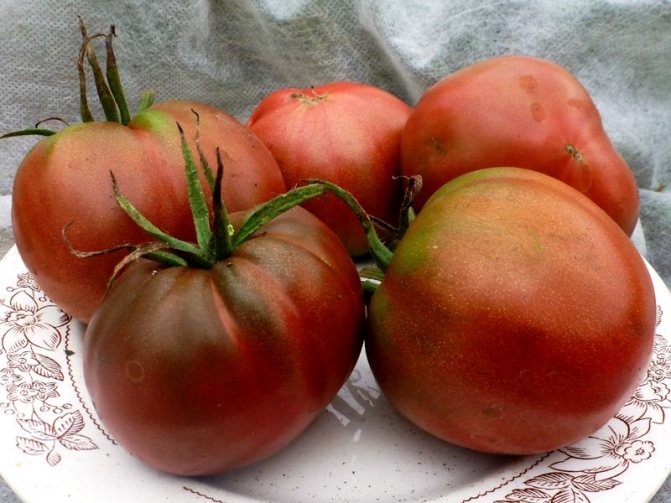

The height of the hybrid is approximately 1 meter, which may require additional support for the bush. The fruits have a greenish tint and are rather large (350-450 grams).Tomatoes work best when eaten fresh, but they do well in cold storage.
Fruit
Fruits begin to appear about two months after the seedlings are planted in the garden. At first, they are green, after which they begin to ripen and acquire a deep and rich shade. Ripe tomato has bright red, burgundy, yellow, pink colors, depending on the variety, as well as a soft structure. You cannot squeeze the fruits when checking for ripeness, otherwise you can damage them, after which they will rot and become unusable.
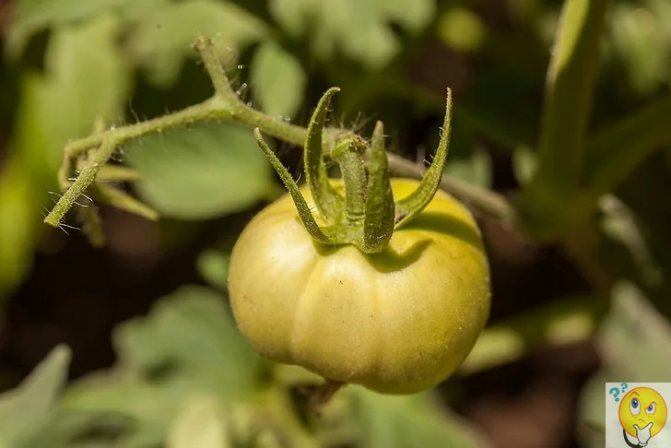

Also, it is also impossible to leave a tomato on a branch for too long, it will overripe or it will be eaten by animals or birds. Experienced gardeners recommend picking the fruits before they ripen, when the color is just beginning to appear. Then put them in the cellar for full ripening. But at the same time, a rich and sweet taste appears only when ripe on a branch. Therefore, it is up to the summer resident to decide how best to act.
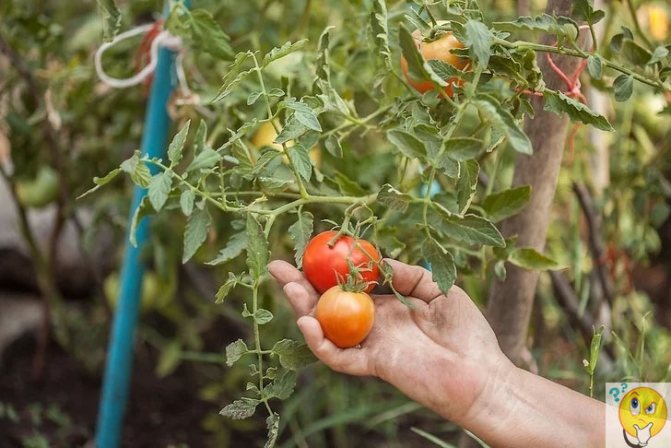

Varieties with immunity to late blight
Half-fast F1
An early variety (86-91 days) with wide bushes growing from 60 to 65 centimeters. The fruits are most suitable for preservation (size from 100 to 150 grams). However, tomatoes will also appeal to those who like to make fresh salads.
Rich hut
One of the most highly resistant to late blight varieties, which is also easy to care for. The size of the fruits is average - from 200 to 300 grams. Low-growing bushes - from 0.6 to 0.7 meters. The plant does not require pinching and additional support.
Boney MM
In addition to resistance to late blight, tomato also boasts almost complete immunity to pests. However, in order to grow a crop, you will need to regularly tie up adult bushes and constantly remove the fruits, which are formed on a cyst in 6-7 pieces.
Gnome
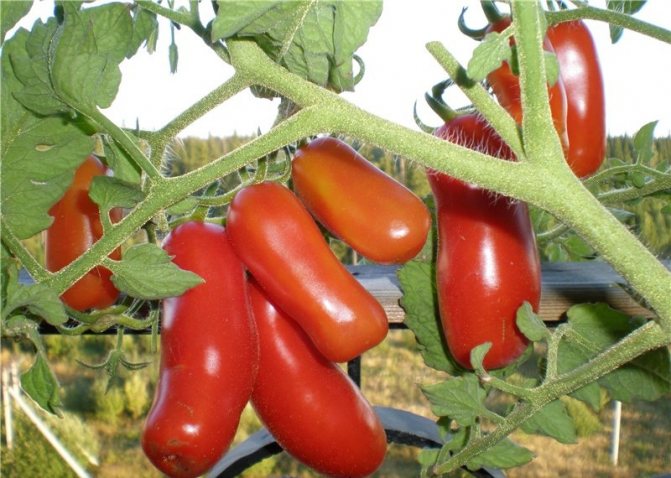

An early ripe variety (91-106 days), which is distinguished by the small size of the bush (up to 50 centimeters) and fruits (up to 60 grams). Despite this, tomatoes are practically not susceptible to cracking after a long period of lying. Suitable for curling and cutting into salads.
Amur bole
This variety differs from the others in its high yield, as well as unpretentious care (especially when it comes to watering and feeding). Tomatoes are small (100-150 grams), but quite tasty and juicy, so they are suitable not only for conservation, but also for processing.
How to plant seedlings
You need to plant seedlings deeply, burying half or even two-thirds of the sprout (especially if the stems are thin, long and brittle). The lower leaves can also be buried. At first, the plant takes root in the new soil and forms a root system, so nothing bad will happen. Rather, on the contrary, the bush will grow strong and resistant to winds and bad weather.
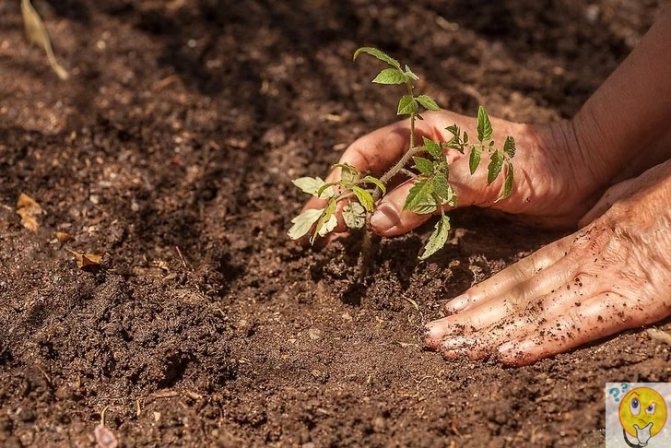

In order for the sprouts to take root better, to take the soil well, they need to be watered abundantly - about 4 liters per bush. The water should be warm (about 25-30 degrees), and this should be done immediately after transplanting.
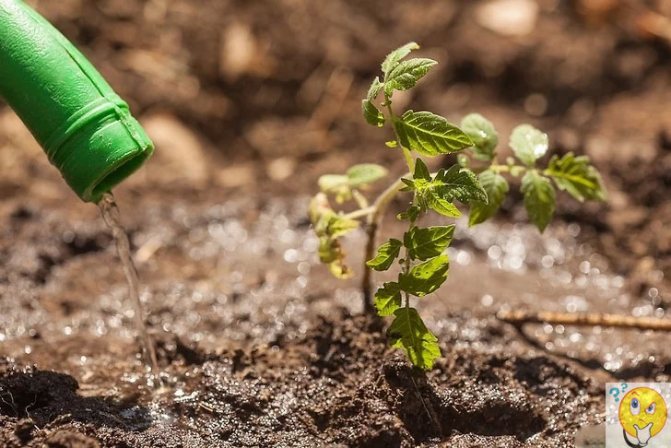

It is necessary to plant tomatoes at a distance of 50-90 centimeters, depending on the variety and climate. This is necessary so that the bushes can dissolve foliage on the ground, it is convenient to water and huddle them, get rid of weeds and tie them up if necessary. If you have a hot climate in your area, the tomatoes can be planted closer together to avoid burning the plant in the sun. With this arrangement, the fruits will be sweeter. Do not forget that small seedlings will soon grow too and need space, so plant all bushes evenly and at an optimal distance.
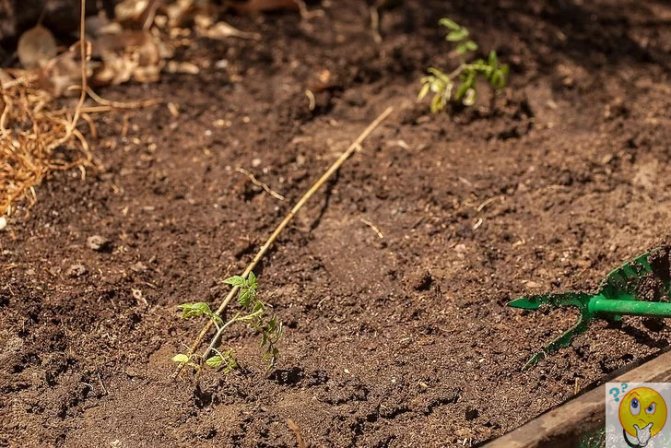

The most productive tomatoes
Puzata khata
Despite the fact that the variety is early, everyone will envy its yield. The bush reaches a height of 1.5 to 2 meters. Fruit weight is average (150-250 grams). They are distinguished by a pot-bellied shape, and also look beautiful after cutting.
Crimson giant
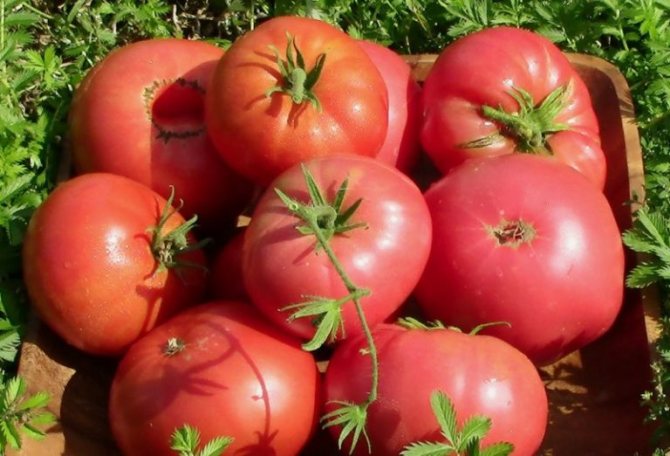

Determinant high-yielding variety with a bush height of 0.9 meters.Recommended to grow with extra support and moderate pinching. The fruits have not only excellent taste, but also medicinal properties.
Stolypin
High-yielding and cold-resistant variety. The germination period is 95 to 105 days. The size of the bush is from 0.6 to 0.5 meters. It is recommended to form a crown. The fruits are small (from 90 to 120 grams). Good for both preservation and consumption.
How to protect fruits from pests
Like many vegetables and fruits, tomatoes can be affected not only by specific diseases, but also by various pests (insects, animals and birds). In order for your fetus to remain intact and safe, the following manipulations must be carried out:
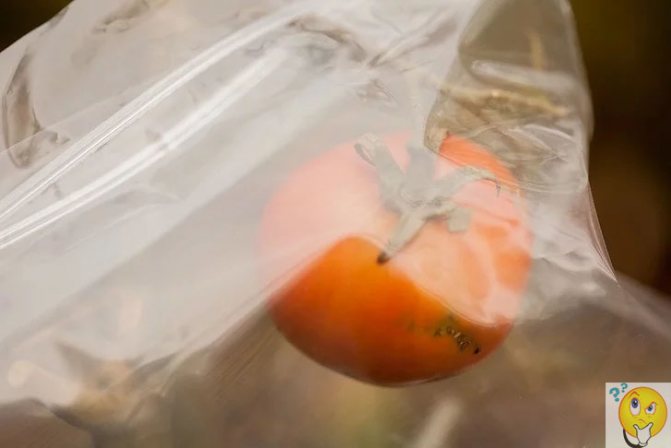

- put a bag on the fruit, fasten on both sides of the branch, leaving holes a few millimeters on each side for air to enter,
- the lower corner of the bag must be cut off, this is necessary for additional air passage and the drainage of excess moisture,
- if the weather is hot, then several holes can be made in the bag,
- you can hang several Christmas tree decorations on the cage, this will confuse the birds and animals that steal tomatoes from you.
Self-pollinated tomatoes
Monomakh hat
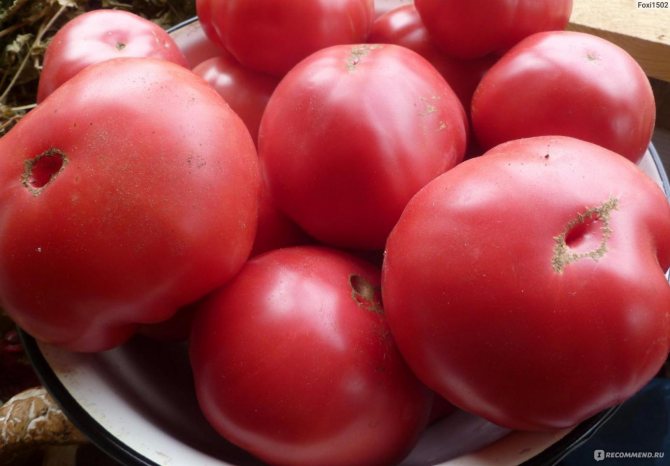

A very famous variety in greenhouse circles, which is also suitable for outdoor cultivation. The size of the bush is only 1.5 meters. The best results will be achieved with crown formation. Tomatoes are very large - from 500 to 800 grams.
Mikado
A pink tomato with a ripening period of approximately 105 days. Fruits are medium (200-300 grams), sweet, fleshy. Best suited for fresh consumption or sale.
Eagle heart
A mid-ripening self-pollinated variety grown in Central Russia. Among the main qualities of the fruit, it is customary to distinguish a large size (up to 400 grams), as well as a low tendency to cracking.
Photo of a big harvest
In the photo you will see what a good harvest of sweet tall tomatoes looks like after the formation of a bush during cultivation:
Low-growing varieties
Bobcat
The tomato is recommended for growing outdoors under a film cover. Does not require additional support and pinning. The size of the bush reaches 70 centimeters. Fruit weight - from 150 to 200 grams.
Alaska
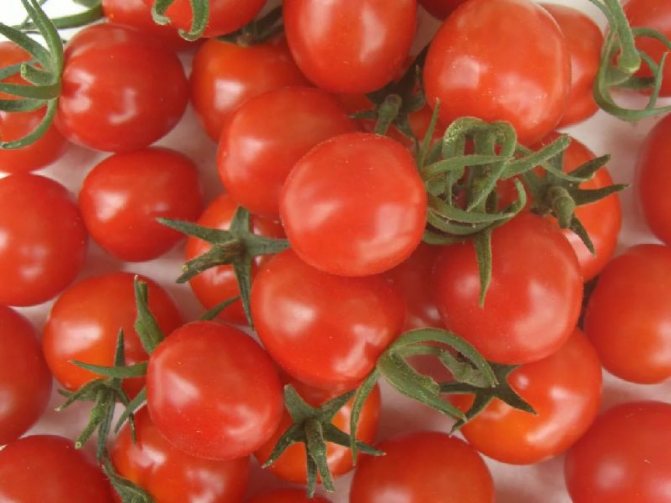

One of the most popular early maturing varieties (ripening time about 85 days), which is suitable for growing in regions with cool summers. The bush is low - from 0.4 to 06 meters in height. Tomatoes are medium in size (about 150 grams).
Abakan pink
Large-fruited (up to 500 grams) variety with intensive growth and extended fruiting. It is recommended to form 1-2 stems, and also regularly remove stepchildren under the first brush. The fruit is best used for processing.
Planting process
To get a good harvest of tomatoes, you have to follow a number of rules regarding their cultivation and care, namely:
- choose a suitable place and soil for landing;
- plant correctly;
- take proper care of it.
To plant a tomato, you need to allocate a sunny place that is well protected from the cold wind. They are not suitable for damp, low areas in which groundwater is located close to the surface. Such places negatively affect the root system of plants. Tomatoes can be grown in the same place for several years..
Attention! By the time the seedlings are planted, the soil should warm up to a depth of 20 cm to + 10 ° С ... + 12 ° С. They are planted in a permanent place in the month of May. If it is cloudy on the day of planting, then you can plant in the morning, if it is sunny - then by the evening. Seedlings must be fresh at the time of planting.
Even with its slight wilting, the bushes will slow down their growth, there may be a partial fall of the first flowers. Most often, tomato seedlings are planted in nests. There are two standard layouts: square and tape.With a square scheme, the size of the hole for varieties of standard, determinant and spreading early ripening is 70x70 cm.They are planted in a nest in 2-3 bushes.
Medium and late-ripening varieties should be planted in a 1x1 m hole, two seedlings each... The strip scheme represents irrigation furrows every 1.4 m. Tomato seedlings are planted on both sides in 1 nest at a distance of 70 cm to the other nest. The distance can be changed. However, gardeners are advised to leave a space of at least 0.3 m3 for growing a tomato bush.
The soil must be shed with hot water with potassium permanganate: 1 bucket for 8 holes. Fertilize with mineral compounds with humus - 1: 3. Remove the seedling carefully. Tear off all the leaves, leaving the top three. Put a bush with an earthen lump in the hole, add compost, tamp, cover with dry earth. Do not cover the stem with soil.
On top, arrange a mulching layer of 10 cm from:
- sawdust;
- straw;
- withered grass.
Only after 15 days, the plants are spud up to a stem height of up to 12 cm.
The most productive varieties that do not require pinching
Buyan
Tomato for growing in cold regions of Russia. Differs in fruits of medium size (about 250 grams), as well as unpretentious care. It is extremely rarely exposed to misfortunes from pests. Resistant to phytophthora.
Newbie
A productive variety that will need to be grown with a temporary cover film. Fruits from 80 to 100 grams are suitable for pickling. Tomatoes also tolerate transportation and cold temperatures. They have a weak susceptibility to mechanical damage.
Solerosso
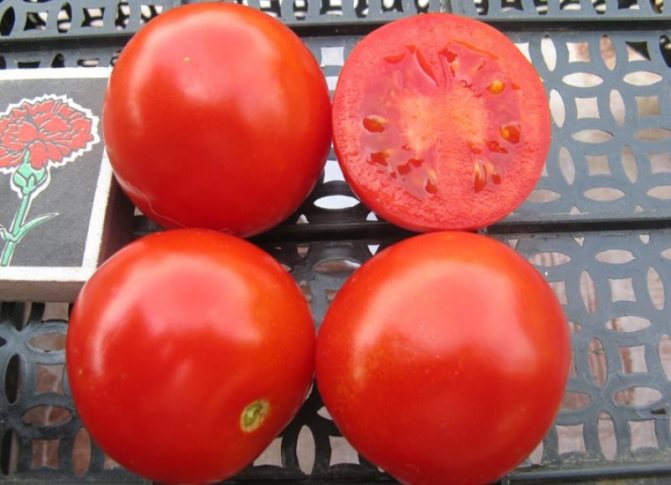

A Dutch variety with a growing period of 90-95 days. Differs in wide leaves that cover the fruits (40-60 grams) from the hot sun. Ideal for hot growing conditions.
Selection of purchased seedlings
Acquisition from nurseries or self-cultivation? The answer is most obvious for those who do not have enough time to sow in pots and harden plants. In addition, when buying seedlings, there is the possibility of purchasing plants of various varieties and maturity dates. Growing and labeling large numbers of seedlings at home is a hassle task.
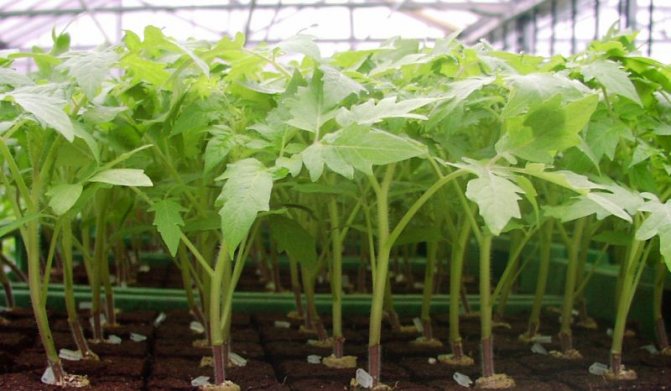

It is risky to buy seedlings from private owners. If they independently prepared the seeds of hybrid tomatoes, then the offspring will be less productive and earlier than the mother plant. There is a high risk of acquiring contaminated planting material.
It is recommended to purchase seedlings in containers with soil. The age of the plants should not exceed 60 days, the height - up to 25-30 cm. Although you can plant seedlings with flowers in the ground and get the first fruits early. It is desirable that the stems below are thick, darker in color. The root system must be well developed and free from damage.
By the appearance of the seedlings, it is determined whether the plants are sick or healthy. Signs of disease - spotted, deformed leaves, shoots. It should not be hoped that after planting it will be possible to quickly correct defects by spraying with pesticides.
The most delicious large-fruited varieties of low-growing fleshy tomatoes
Yamal
An early but unpretentious open field variety. Small rafts (90-120 grams) have a slightly flattened shape, suitable for conservation. The tomato is not susceptible to most tomato diseases.
Summer resident
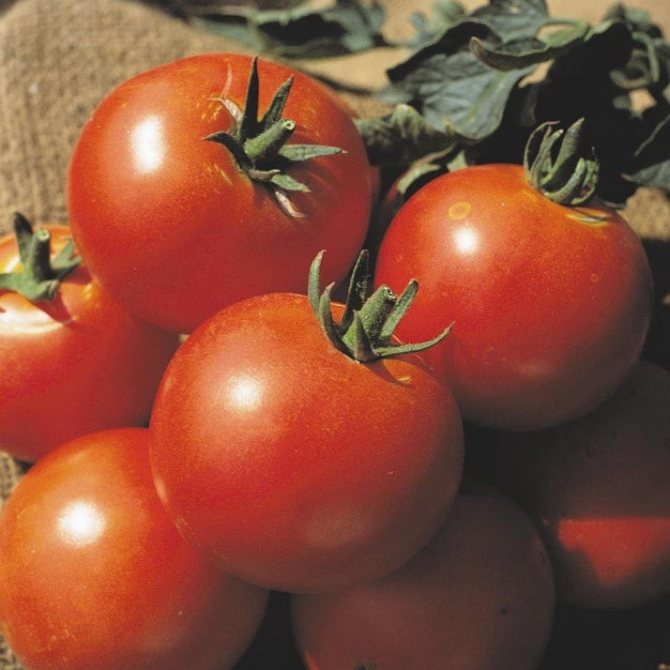

A productive variety that is unpretentious for growing outdoors. The height of the bush is 70-80 centimeters. Fruit size is medium (150 grams). The main purpose of tomatoes is preservation, but they are also well suited for sale.
Fat jack
A variety with one of the most powerful bushes, which reaches 0.5 meters in height and does not require tying. On average, tomatoes grow from 200 to 300 grams, but giants often come across, weighing 500 grams. It is very common in the south of Russia.
Non-hybrid sweet varieties
Bush formation
It is necessary to form a tomato bush in time, otherwise the plant will give all its strength and nutrients to the lower leaves, stepsons and unnecessary branches. In contact with the ground, the lower leaves become a conduit for infections. Experienced summer residents are advised to cut 1-3 lower leaves, starting in June, every week until the first inflorescence. This will provide good ventilation and remove unnecessary stress from the leaves.
The foliage is removed in dry warm weather, preferably in the morning. The wound should have time to tighten without becoming an entrance gate for bacteria and fungi. How many leaves to remove from the bush, the summer resident should be guided by the inflorescences and fruits. Until all the fruits are tied on the brush, on top, that is, above the brush, all the leaves should be present. How to properly form a bush, look at this picture.
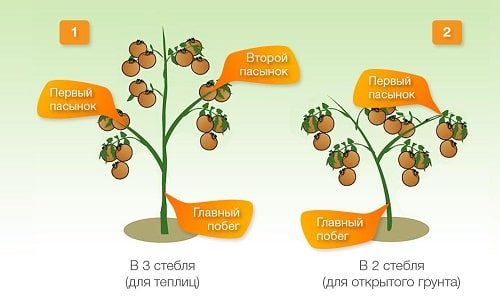

Cherry
A variety that needs no introduction. The bushes are powerful, reaching 70 centimeters in height. The first harvest occurs 95 days after seed germination. The fruits are small enough (up to 50 grams), intended mainly for conservation.
Southern tan
Mid-season variety with yellow fruits. The shape of the tomato most closely resembles a chicken egg. The berry mass reaches from 100 to 120 grams. They are extremely tasty and also great for sale.
Incas F1
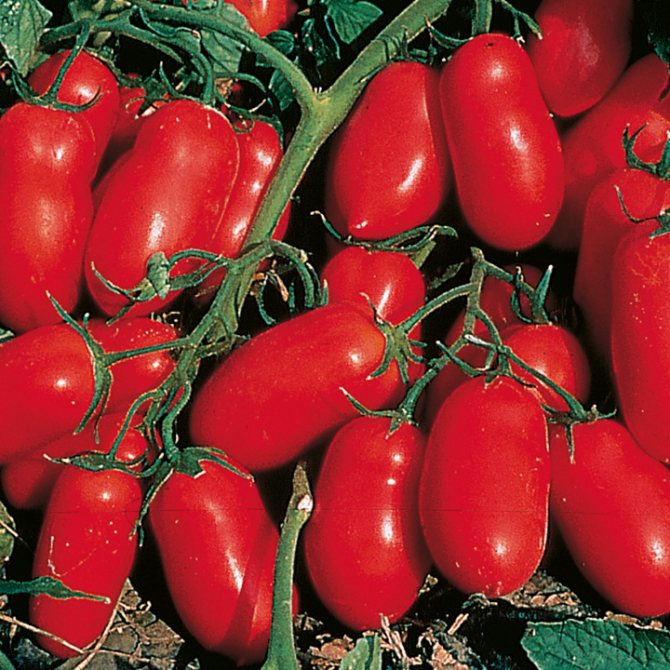

The seeds of this plant are quite popular because they were bred in Holland. It is recommended to grow under a film cover, but this is not too important. Small tomatoes - from 80 to 100 grams. During cultivation, nitrogen and phosphorus fertilizers will be required.
Russian Empire F1
A brush hybrid suitable for growing in central Russia. The fruit is an elongated cream of red color, the weight of which is 150 grams. The variety is suitable for salting, and is also in demand in the market. The fruits endure mechanical damage, so there is no need to worry about damage to the goods during transportation.
Aunt Valya F1
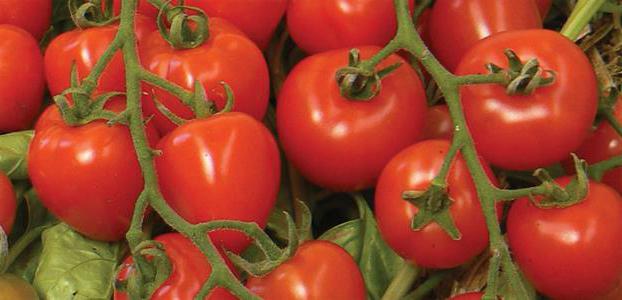

An unpretentious and popular variety, featuring small bushes and medium fruits (150 grams). Tomatoes are not susceptible to cracking due to exposure to sunlight. They have good taste and strong aroma. They are distinguished by strong immunity.
Hilling
The stronger and stronger the roots of the fruit, the more they provide the plant with nutrients, the larger the tomatoes will be. Therefore, the bushes must be hilled. Hilling is carried out at the time of root growth. And the roots grow in periods. This frequency is proportional to development. First, the roots grow vigorously, then they slow down their growth, and the vegetative mass begins to actively grow. Then the growth of the roots is again activated, up to the moment when flowering and fruit setting begins.
The hilling time will be prompted by the plant itself. Watch the stem closely. If on the stem near the ground itself there are bulges that look like pimples, then it's time to huddle up for the first time, always with damp earth. When the stem near the ground changed color from green to bluish, it was time for the second hilling.
Timely hilling gives rise to a strong root system and gives more strength for the harvest.
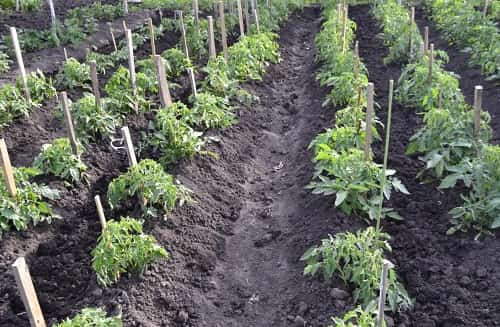

Diseases and pests of tomatoes
Fungal, bacterial and viral diseases are dangerous for tomatoes. To combat the first group of pathogens, once a decade, tomatoes are treated against phytophthora and fusarium wilt with Bordeaux liquid. Strong fungicides can be used 2 times per season.
Tomatoes affected by bacterial infections are treated with solutions of Baktofit or Fitosporin preparations. The second remedy is also used against fungus. Biological products are less dangerous for humans, they are used for spraying up to harvest.
The most effective method of combating viral diseases of tomatoes is the breeding of resistant varieties and hybrids.Be sure to disinfect the seeds before sowing with a solution of potassium permanganate (if you can buy this antiseptic at the pharmacy).
Dangerous pests of tomatoes are bear, wireworm, Colorado potato beetle, nematodes. The moth caterpillars are capable of destroying the crop by eating the fruits from the inside. The control measures used are the same as on other nightshade crops.
What can be planted after tomatoes
Compliance with the rules of crop rotation on the site is a guarantee of a good harvest of various types of crops, therefore, in order to get tasty and large tomatoes every year, you will have to constantly change the place of their cultivation, at least once every 2-3 years.
Did you know? Mustard seeds contain a lot of useful substances, among which it is worth noting phytoncides and antibacterial components that act as a natural preservative for better preservation of food. When cooking meat, a small amount of mustard powder is sufficient to prevent the juice from leaking out.
While the tomatoes are growing elsewhere, you can plant in the same area:
- cabbage;
- cucumbers;
- zucchini;
- pumpkin;
- squash;
- beans;
- peas;
- garlic;
- salad;
- beets;
- carrot;
- parsley;
- dill;
- celery.
Legumes and greens will saturate the soil depleted by tomatoes with nitrogen, onions and garlic will help improve the soil and increase yields, pumpkin seeds will serve as a restorative top dressing. Using green manure plants is a good option, especially if the grown tomatoes are suffering from disease. Such crops are rye, winter wheat and mustard, which are dug up in spring after winter sowing.
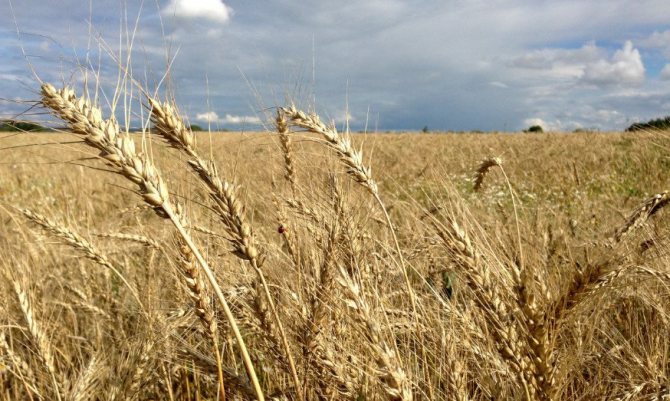

Preparing the land in the beds
Where do tomatoes grow on the site best? The tomato beds in the garden are supposed to be equipped in well-lit, wind-protected places. The soil on the site chosen for growing this crop must first be fertilized with rotted manure.
Tomato beds are best cooked narrow. In this case, it will be easier to care for the plants in the future. Having formed such beds, inside them, half a bucket of manure should be poured in with a step of about 50 cm. Next, you need to dig up the earth with a shovel and level it with a rake.
Harvesting and storage
In July, August, September, ripe fruits are harvested for fresh consumption and canning. After night temperatures drop, green tomatoes can be harvested, stored at temperatures up to 18 ° C for ripening. Brown fruits, on which light falls, reach ripeness faster.
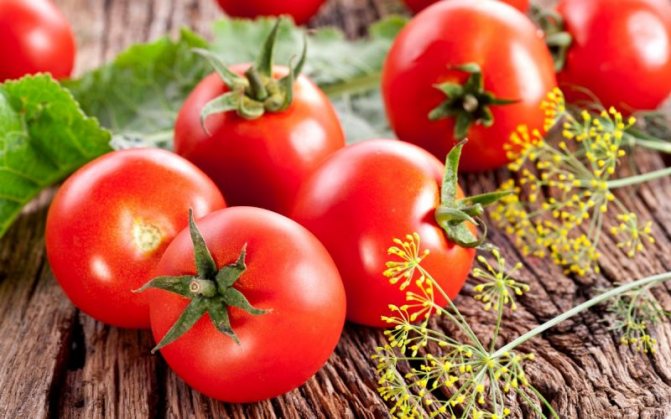

Put tomatoes for ripening in flat boxes in one or two layers. The stalks are removed, but so as not to damage the skin and pulp. Add a few red ones to green and brown tomatoes to speed up ripening. It is better to store ripe fruits in a cool dry place, but not in the refrigerator.
How to get tomato seeds yourself
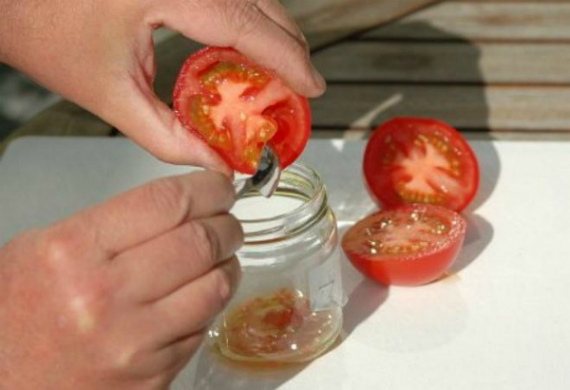

If you like the tomato variety, you can prepare its seeds in order to grow exactly the same vegetables in the future.
It is important to know that this method is only suitable for varietal tomatoes, the property of hybrids through seeds is not inherited. Hybrid plants are obtained by crossing several varieties at once, they completely degenerate in 1-2 years.
For self-harvesting of seeds, the fruits must be removed from healthy, strong bushes. It is necessary to remove tomatoes from the lowest branch, then there will be less risk of getting a cross-pollinated hybrid. The tomato should be fully ripe on the branch. The vegetable is then cut into slices to gain access to the seed chambers.
The seeds, together with the juice, are removed with a spoon and placed in a glass bowl. There should be enough juice to completely cover the seeds. After that, the container is loosely covered with a lid. Then they wait about a day until the fermentation process is completed.
As soon as a film appears on the surface and air bubbles begin to form, the seeds are removed, washed in running water, and then dried thoroughly. The seed is stored at room temperature in a paper bag, on which the name of the variety and the date of collection should be written. The bag must be removed before spring in a dark, dry place.
Location
In Russia, for the most part, tomatoes are grown outdoors... This is true for regions with a fairly warm climate, such as:
- Voronezh;
- Rostov;
- Kursk;
- Tambov Region;
- Krasnodar region.
But the ability to grow tomatoes in greenhouses makes it possible to cultivate this vegetable even in winter in Murmansk and Arkhangelsk. In terms of the cultivated area for tomatoes, Russia ranks eighth in the world. Most of the territories for these purposes are involved in China, India, and Nigeria, followed by Turkey, Egypt, the United States and Iran.
Why don't they bear fruit
- High humidity in the greenhouse. High humidity in the greenhouse is detrimental to the crop. The optimal mode should be 60%. A closed, unventilated and clogged greenhouse on all sides can cause great damage to the crop. At high humidity, pollen clumps together and pollination of flowers does not occur.
- Lack of moisture in the soil. During the setting and growth of fruits, tomatoes especially need moisture. If you skip watering, then dry soil can cause shedding of flowers. With insufficient watering, the growth of fruits stops, and abundant watering after a drought leads to cracking of the fruits. With this approach, you can forget about a good harvest.
- Unbalanced diet. Tomatoes are very fond of nutritious soil and additional feeding, which can also play a role in the absence of fruits. With an excess of nitrogen in the soil, the plant begins to gain green mass. This becomes noticeable when a dark green leaf cap is formed. At the same time, the flowers are modified and become sterile.
Pollination
Tomatoes are self-pollinating plants that deal with this issue easily. Insects - bumblebees and bees - are of great help in the pollination process. To attract them to the site, you can plant such fragrant honey plants as mint, rapeseed, lemon balm, coriander, mustard, basil.
In some cases, artificial pollination is required:
- Each bush is shaken a little.
- You can just tap the blooming brush, but not too hard.
- This procedure is carried out in the morning.
- After pollination is complete, you need to spray or water the tomatoes with warm water so that it flows over the flowers.
When and how to spray
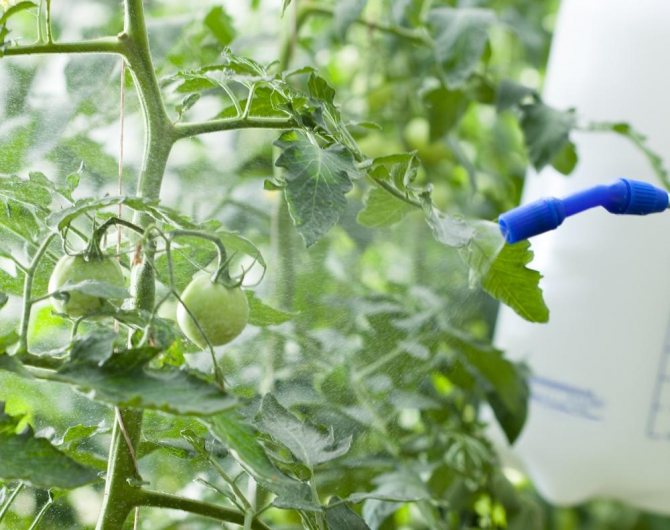

Most often, tomatoes are sprayed from phytophthora
Changes in day and night temperatures, morning fogs negatively affect the condition of tomatoes, lead to increased susceptibility to fungal diseases, as well as to a decrease in the number of fruit set. The purpose of summer spraying of crops is to prevent fungi and stimulate the formation of ovaries.
The most common tomato diseases are late blight and cladosporiosis. To prevent these diseases, the bushes are sprayed with copper-containing preparations: HOM, Oxyhom, Profit, Bordeaux liquid. The procedure is carried out 3 times during the summer:
- 2 weeks after planting seedlings in the ground;
- at the beginning of bud formation;
- during the appearance of the first ovaries.
To stimulate the formation of a large number of fruits after the blooming of the first flowers, the bushes are treated with the preparations Ovary, Tomaton, Feokarpin, Boroplus. Spraying 1 weave will require 20 liters of solution.
Tying tomatoes
Tall varieties need additional tying. This prevents the plants from falling to the ground and makes harvesting easier. The tying procedure itself is very simple:
- A peg is installed next to each plant that will be tied.
- You can dig strong stakes along the edges of the row, then pull a cord or twine between them.
- Twine is considered an excellent material for garters, as well as synthetic thick threads. The main advantage is that they do not rot.
- You can use metal or wooden stakes.
- Tying plants to a peg or wire should not be very tight.
- To strengthen the stems, a net, lattice or a twig cap can be used.
The main problems associated with growing
Tomatoes are highly susceptible to low temperatures, they do not tolerate excessive moisture and lack of light. Even the best zoned varieties are weakly resistant to unfavorable environmental factors if they do not receive proper care.
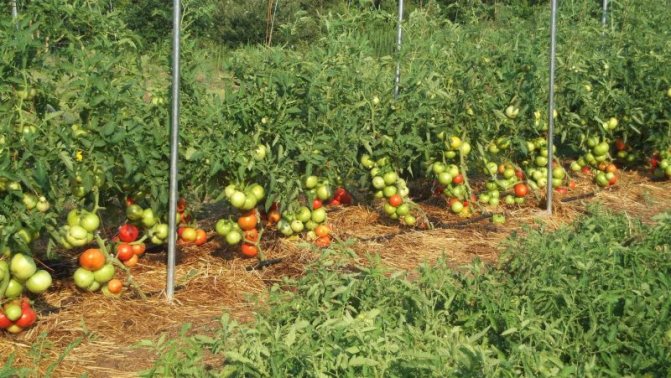

In conditions of a lack of water, the leaves turn yellow and dry, the fruits remain small and tough. Excess moisture is also harmful: roots rot, fruits crack. Bushes overfed with fertilizers increase the vegetative mass to the detriment of fruit set. Leaves and fruits on a hot afternoon can get sunburn, which looks like whitish spots.
Soil preparation
Tomatoes prefer open, well-lit areas, fresh fertile soils. Tomatoes do not grow well in lowlands or in high places that are blown by the wind. In a crop rotation, tomatoes are best grown after peas and other legumes. Good predecessors of root crops: beets, carrots. Areas where potatoes and eggplants were grown in the previous season are not suitable.
The site is prepared in advance: it is dug up, leveled with a rake. Poor soils need the addition of peat, humus, wood ash. You can pour humus directly into the hole during planting.
Top dressing
You need to feed the tomatoes at least three times a season, and even better - do it constantly, every two weeks. Fertilizers can be used in different ways, the main thing is that there is less nitrogen in them than phosphorus with potassium, for example: 15 g of ammonium nitrate, 50-60 g of superphosphate and 30-40 g of potassium chloride per 10 liters of water. However, they also respond well to a solution of bird droppings. Of the microfertilizers, they need magnesium and boron most of all: magnesium - constantly, and boron - when they bloom, because flowers and ovary can begin to crumble from a lack of it. For top dressing, you need to take 1 g of boric acid per 1 liter of water and spray the herbs in the afternoon.
Description of the plant
There is hardly a person who does not know what a tomato is, so we will briefly describe this plant. Tomato or tomato (both names in Russian are equal) is an annual or perennial herb, a species of the Solanum genus of the Solanaceae family. It is cultivated as a vegetable crop. Due to the popularity of this culture in the world, many of its varieties have been bred, and in the State Register of Russia their number exceeds the number of varieties of any of the registered plants. Tomatoes are grouped according to various criteria:
- By type of growth: determinant, that is, those whose growth is limited by the formation at the top of the flower brush;
- indeterminate - the growth of such bushes is not limited and, in the presence of favorable conditions, lasts up to 10-11 months (in heated greenhouses).
- early maturing;
- canteens;
- red;
Photo gallery: tomatoes of various colors
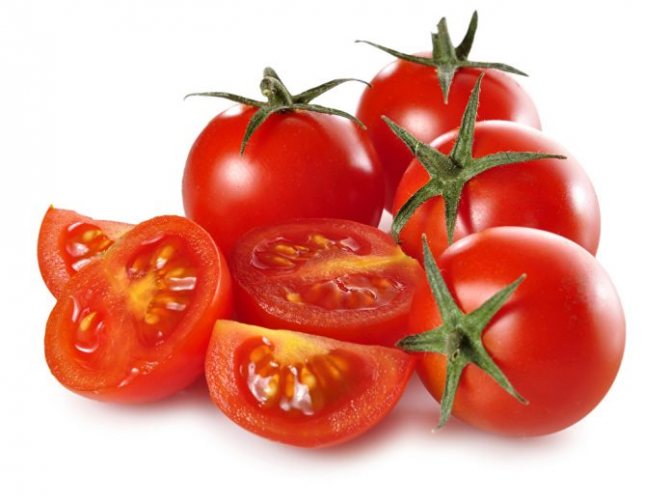

The fruits of red tomatoes are most common in our country.
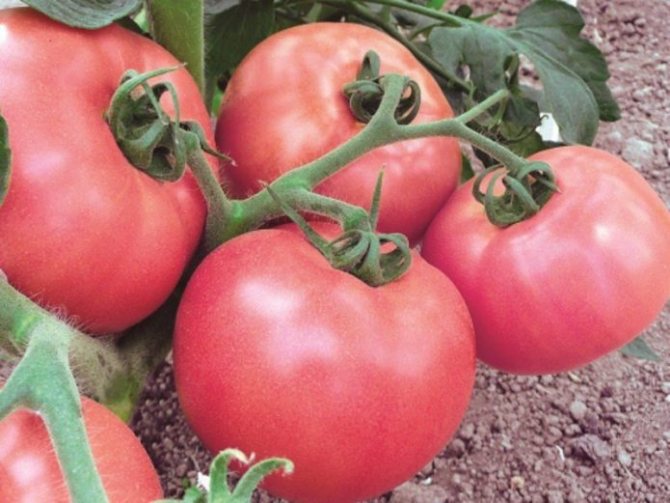

Fruits of pink tomatoes are more often for salad purposes.


The fruits of yellow tomatoes look decorative


Green-fruited tomatoes are bred by exotic lovers
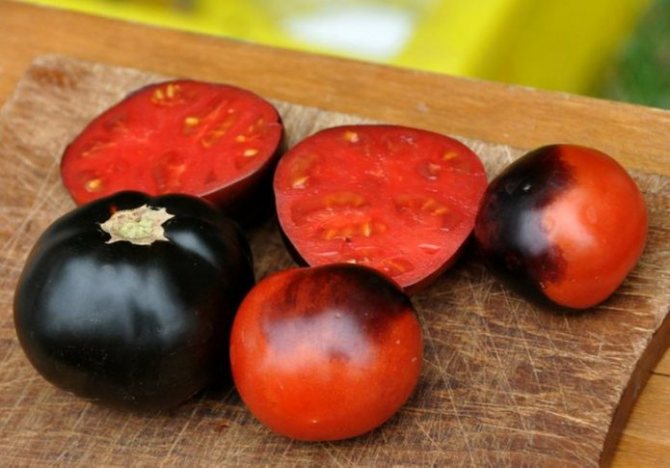

The fruits of black tomatoes look very original.

